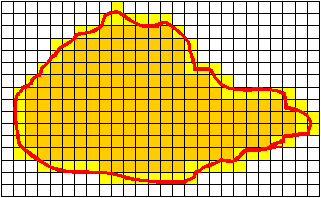| P | O | L | .. Y | A |
| A | ... O | M | I | |
| N | O | E | S | |
Till now, there is no formula for calculating the number of different polyominoes, but only some results (for smaller values of n), obtained by empirical derivation.
In every border square cell of a polyomino we could introduce two-sided mirrors perpendicular to the internal edges in their mid-points. After series of reflections, the ray of light will "describe" the shape: a closed Dragon curve. If we denote a reflection in a border mirror by 0, and a reflection in an internal mirror by 1, we have 0-1 words (or symbols) for polyominoes, where these words are cyclicaly-equivalent (this means, could be readed starting from any sign 0 or 1 and ending in it):
 0000 for polyomino 1.1
0000 for polyomino 1.1
From their symbols we could directly make conclusions about the symmetry: every reversible word denotes polyominoes with a sense-reversing symmetry (they don't have "left" and "right" form); irreversible symbols correspond to the polyominos appearing in the "left" and "right" form (e.g. 4.4 and 4.5).
That symbols (or binary numbers) we could translate into hexidecimal numbers and to every polyomino asign exactly one such number. For example, this could be the minimum of all such cyclic-equivalent symbols (e.g. to the polyomino 2.1 correspond cyclicaly-equivalent symbols 00010001, 00100010, 01000100, 10001000 and the minimum of them is 00010001 = 11 in hexidecimal system. Hence, we have the notation for polyominoes where to every polyomino corresponds exactly one such number, and vice versa. (Opened question: find the general algebraic form of number determinimg a polyomino? Namely, some numbers will determine "opened polyominoes", "holow polyominoes" or "overlaping polyominoes", that are not included in our definition, and other will determine "real" polyominoes.)
Every (n+1)-omino we derive from some n-omino by adding to it a single square. Certainly, the addition operation is positional one, this means, the result depends from the position where we add the new square.
Here we have the following addition rules:
This "algebra" could be successfuly used for the computer enumeration of polyominoes. In each step we need to derive (n+1)-minoes from n-minoes by adding a square, to test the equality of the (large number) of polyominoes obtained and to make a complete list of the different (n+1)-minoes obtained.

Every curvilinear shape (equivalent to a topological disk),
placed in a regular plane tiling (44) (i.e. in a
regular square grid) is enclosed between a maximal
polyomino contained in it and minimal polyomino containing
it. It could be approximated by this
maximal and minimal polyomino. The precision of
this approximation depends from the choice of the
grid, and could be
always rafined.
Polyominoes (either black or white) appearing in Lunda
designs will be called Lunda polyominoes.
The possible shape of Lunda polyominoes is conditioned by
the local equilibrium condition for Lunda designs.
Therefore, some polyominoes are inadmissible (e.g. 4.3,
or the following 10-minoes) as Lunda polyominoes.
By introducing the concept of Lunda animals, P.Gerdes in his book "Lunda geometry: Designs, Polyominoes, Patterns, Symmetries" obtained the first approximation for the total number of different Lunda n-ominoes.